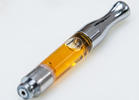
Pre-filled vape cartridges are affordable, discreet and can get you really high. But what if yours contains trace amounts of lead? That's a real possibility, according to several California testing facilities.
New regulations went into effect on January 1, 2019 that drops the acceptable level of lead in cannabis products from 4 ppm to 0.5 ppm. As cannabis producers scramble to comply, their worst fears are coming true: Some of the products are failing the new heavy-metals test.
What Did the Testing Really Show?
SC Labs has tested thousands of cartridges and only about 0.5% (5 out of 1,000) failed the lead test. Insiders say other labs have shown a higher number of failures, but it’s still a really small percentage.
However, there’s no safe level of lead in any product, says the Center for Disease Control and Prevention. Lead poisoning is devastating to children, but it’s bad for adults too. It can cause headaches, memory loss, pain, mood disorders, fertility problems and, in extreme cases, death.
What Are California’s New Testing Requirements?
Cannabis producers were made aware of new testing requirements long before the new rules were implemented. California started phasing them in on January 1, 2018 with the third and final phase going into effect on January 1, 2019. Each set of rules applies to the time when products were made, not sold, so vape cartridges that would not pass Phase 3 testing may still be available to buy.
• Phase 1 measures cannabinoid levels, moisture content and basic contaminants including pesticides, fungus, mold and salmonella.
• Phase 2 added foreign materials testing.
• Phase 3 measures terpenes, mycotoxins and heavy metals like lead.
To read the rules, go to “Article 5: Laboratory Testing and Reporting” (page 104).
Where Does the Lead Come From?
Any plant can pick up trace amounts of lead from the environment, but most believe these higher lead levels of are coming from the cartridge hardware. Virtually all are either made in China or assembled in the U.S. from Chinese parts. Chinese manufacturers mix lead with other metals to make the cartridges more durable and easier to work with.
The lead leaches out of the cartridge components into the vape liquid; the longer the oil is allowed to sit, the more lead it may contain. That means older products that have been sitting in storage will probably be more dangerous than those that were freshly filled. And, if the liquid is tested in bulk before the cartridges are filled, it could pass the heavy metals test, but still be contaminated with lead by the time you use it.
Cannabis vape cartridges aren’t the only products affected. Most nicotine-based e-cig products are also manufactured in China and traces of lead have been found in some of those products too.
Are All Cartridges Affected?
Cartridge makers don’t have to say whether or not their pre-2019 products passed of failed preliminary Phase 3 testing, and most aren't going public with any problems. To be safe, only buy vape cartridges with a label that states it was made on or after January 1, 2019.
To be even safer, give up the carts for a few months. Chinese manufacturers are busy making more expensive hardware that's 100% lead-free. They won’t hit the California marketplace until later this year. Some cartridge makers are delaying production until they receive the new items; that could lead to shortages, especially if you’re brand loyal.
If you purchase your cartridges from questionable sources, they may not have gone through Phase 3 testing. No cartridge made and sold outside of California will be required to follow these regulations.
What to Do If You Don't Want to Inhale Heavy Metals?
The best way to conszume cannabis and be completely safe is to grow and process your own. Instructions are all over the web and you can order cannabis seeds from reputable seedbanks that include almost every popular strain, from Sour Diesel to Wedding Cake. Not only is DIY-ing it satisfying, it'll give you the peace of mind that can only come from knowing exactly what you’re putting in your body.






